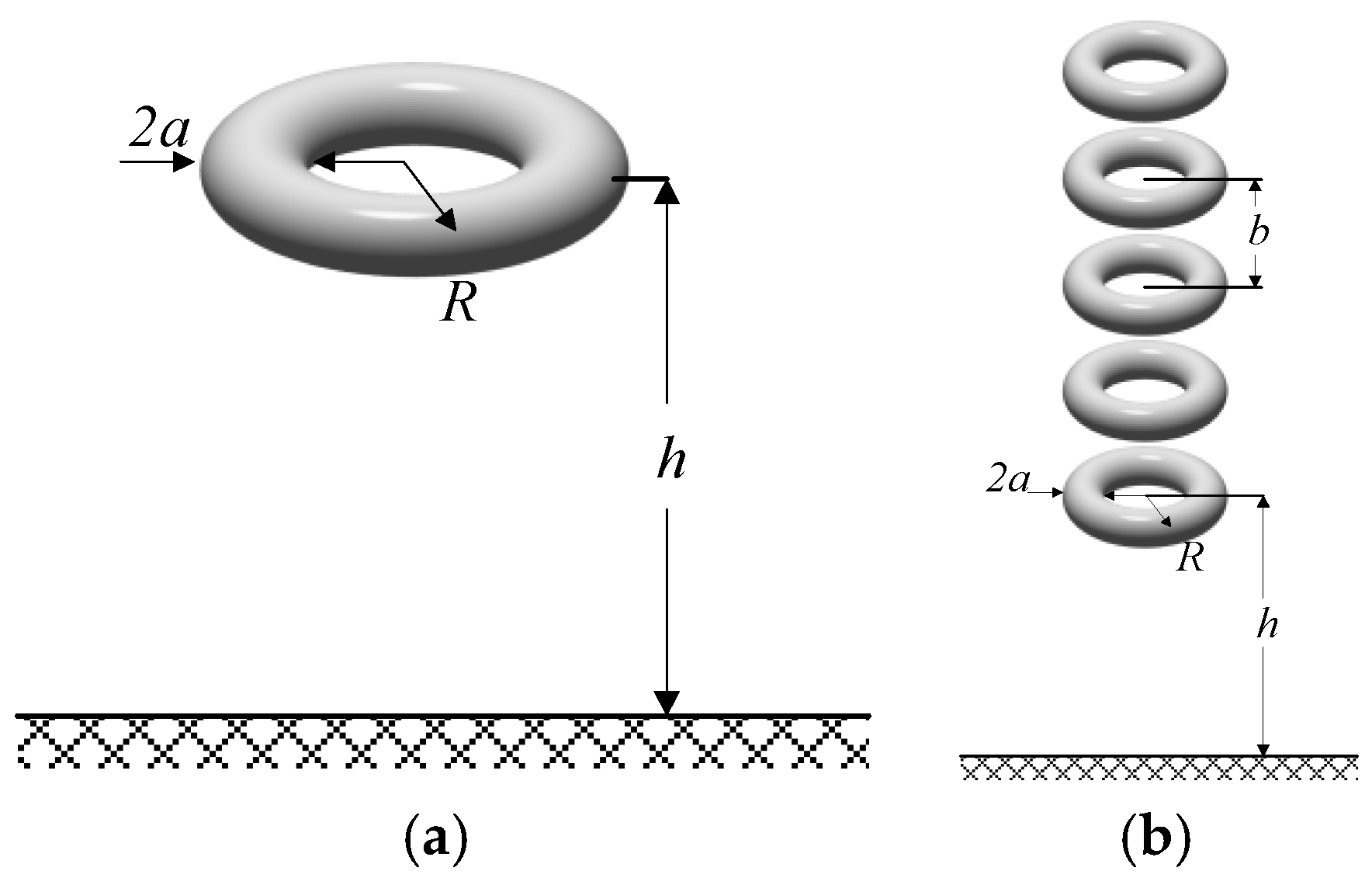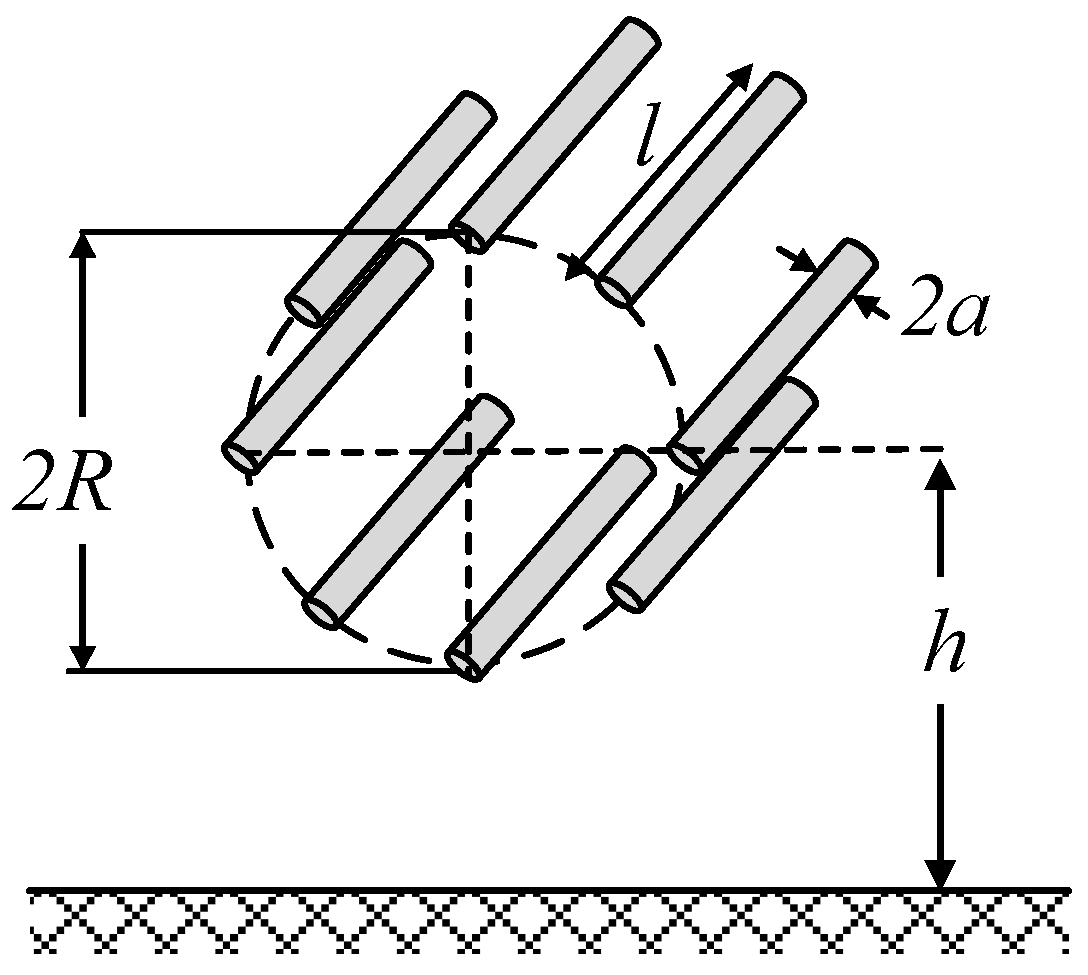1. Introduction
The calculation of capacitance formulas has received little attention compared to the analysis of inductance calculation formulas [
1,
2]. Nearby surfaces separated by an insulating medium such as air, subjected to different electric potentials, induce a stray or parasitic capacitance, and therefore this configuration acts as a capacitor. High voltages and high frequencies tend to amplify the effects of the unwanted stray capacitance. The analysis of stray capacitance effects is of interest in different disciplines, including electrical engineering, high-voltage applications, radio engineering or physical sciences, among others [
3].
Different studies prove that the stray capacitance produces an uneven voltage distribution across each insulator unit in a high-voltage insulator string [
4,
5]. The effect of the stray capacitance is to reduce the efficacy of each additional insulator unit due to the non-linear voltage distribution [
6]. This is because the capacitive current and the corresponding voltage drop across each insulator unit are greater in the insulator units closer to the conductors, due to the effect of the distributed stray capacitances to ground [
7]. The string elements closer to the line are subjected to a higher electrical stress than those closer to the tower. Grading rings can be used at both ends of the string to homogenize the voltage drop across each insulator unit [
8]. A similar effect occurs in high-voltage switching mode power supplies composed of several modules in series, since in [
9] it is proved that the stray capacitance to ground has a significant impact on the individual voltage of each module. In other high-voltage applications, including high-voltage transformers [
10] or high-voltage motors, parasitic capacitances have a key role to predict the frequency behavior of such machines.
Accurate methods to calculate the capacitance are based on the calculation of the electrostatic field generated by the system of charged objects under consideration [
3]. The capacitance of basic isolated geometries, such as very long horizontal cylindrical conductors, coaxial cylindrical conductors, concentric spheres, or spheres well above ground, can be easily deduced theoretically. However, such formulas have very restricted practical use. The calculation of the capacitance of conductive objects which are close to ground leads to challenging mathematical problems, even for simple geometries. Therefore, analytical solutions for capacitance only exist for a limited number of electrode geometries and configurations, which have almost no practical applications [
11], and often only contemplate the stray capacitance to ground, thus disregarding the effects of nearby grounded electrodes, structures or walls [
3].
As a consequence, computational methods are increasingly being applied to solve such problem, although most of the published works deal with very particular problems, such as insulator strings [
4,
5,
7], transformer windings [
10] or voltage dividers [
12], among others. FEM is perhaps the most applied computational technique to calculate the effects of capacitance, since it allows dealing with complex three-dimensional geometries, as reflected in several works [
13,
14,
15,
16,
17,
18,
19].
Since stray capacitances are not easily measurable, because of the low immunity to noise of the small signal to be acquired [
20], results provided by numerical methods are a good alternative during the design stage of high-voltage devices and instruments. Therefore, the capacitance between energized electrodes or between electrodes and ground is a factor to be considered when designing and planning high-voltage projects and tests [
11].
Most works analyze specific problems related to the unwanted effects of stray capacitance, such as in transformer windings [
10], motor windings [
21] or insulator strings [
7], among others. However, there are no recent works providing a systematic account of the problems to calculate the stray capacitance to ground for geometries found in high-voltage laboratories and high-voltage installations such as substations. These geometries include wires, rods, spheres, and circular rings, the latter ones being commonly applied as corona protections. The stray capacitances due to these high-voltage electrodes can have a non-negligible impact on the measurement results and behavior of the devices involved.
This paper is focused to review and analyze the accuracy of different formulas found in the technical literature to calculate the stray capacitance to ground of various high-voltage electrodes. To this end, due to the lack of available experimental data because of experimental difficulties related to the small signal to be acquired and noise immunity, the results provided by the formulas are compared with the results provided by FEM simulations. It is noted that regardless the impact of the stray capacitance in high-voltage applications, at our knowledge, there are no published technical works assessing the accuracy of such formulas; thus this work contributes in this area. Results presented prove that FEM models offer flexibility, simplicity and accuracy to analyze the effects of stray capacitance in high-voltage systems with different geometries.
2. The FEM Approach to Analyze the Stray Capacitance
The stray capacitance to ground is directly related to the distribution of the electric field around high-voltage electrodes [
22]. It is a recognized fact that the effects of stray capacitance can be determined by means of FEM-based approaches [
12,
23].
The capacitance can be calculated from the ratio
C = Q/U, defined by the charge
Q stored in the system and the electric potential
U, supposing that the system under analysis is far from other charged bodies [
3]. Therefore, the stray capacitance concept arises between any two charged bodies subjected to different electric potentials, and can be important in high-frequency and high-voltage applications.
For low-frequency applications, the capacitance can be calculated by analyzing the energy related to the electrostatic field, thus disregarding the displacement current. To evaluate the capacitance of a given geometry, it is necessary to calculate the electric potential on the surface of the analyzed conductor. Next, the outer electric potential and the electric field are calculated within all points surrounding the conducting electrodes, by applying the potential as boundary condition [
14,
24]. Finally, the capacitance of the analyzed system is calculated by applying:
WE being the stored electrostatic energy.
The next paragraphs detail the process to follow for determining the stored electrostatic energy.
From the Gauss law that relates the distribution of the electric charge density (C/m
3) to the electric field
(V/m),
and the relationship between the electric field and the electric potential
U,
, the Poisson’s equation for electrostatics arises [
25],
Equation (3) allows solving for the electric potential and field in all points of the domain [
26]. Next, the energy density in any point of the air domain is calculated as:
The electrostatic energy stored in the domain can be calculated by integrating the energy density over the volume of the domain outside the conductive high-voltage electrode [
14,
27]:
Finally, the capacitance is calculated by applying Equation (1) [
24]. Therefore, the capacitance is calculated from the electrostatic energy stored in the air because of the incitation of
U.
Figure 1 shows the surface meshes applied to some of the geometries analyzed in this paper, including cylindrical conductors, circular rings and spheres.
Figure 2 shows the blocks and meshes types applied in the simulations. Whereas a sufficiently large outer block was used to set the boundary conditions, a much smaller inner block was used in order to apply a much finer tetrahedral mesh to ensure improved accuracy.
Both three-dimensional (3D) and two-dimensional (2D) FEM simulations were carried out to simulate all geometries analyzed in this work. Whereas 3D-FEM simulations were applied to wires of finite length, circular rings and spheres, 2D-FEM simulations were applied to analyze wires of infinite length. Parametric simulations were carried out to automatically change the value of different parameters, such as the height about ground level or the curvature radius of the different analyzed geometries.
Simulations conducted in this work were performed by means of the Comsol Multiphysics package using the electrostatics module. They consist of approximately 0.5–9.5 million tetrahedral elements, 66–590 thousand triangular elements, 0.5–73 thousand edge elements, and 22–96 vertex elements, depending on the specific geometry analyzed.
4. Discussion
This section summarizes the results attained in this work. As deduced from
Section 3, FEM simulations offer more flexibility, generalization capability, and the possibility to deal with more complex geometries than analytical formulas for calculating the stray capacitance of high-voltage electrodes to ground. Although analytical formulas only are available for some simple geometries, they can be effectively applied to determine the straight capacitance to ground of high-voltage electrodes with simple geometries.
Results summarized in
Table 12 clearly show a very good agreement between the results provided by analytical formulas and FEM simulation for wires of infinite length, whereas in the case of straight wires of finite length, maximum differences around 1–5% are found.
Results presented in
Table 13 clearly show that in the case of spheres, analytical and FEM results are almost the same, whereas in the case of circular rings, maximum differences around 5–8% are found.
When dealing with multi-wire configurations, the differences are much higher than in the geometries above, since differences around 5–56% can be found. In addition, for some geometries, the analytical formulas available for multi-wire geometries cannot be applied, since some of the input parameters are out of the applicability limits of such formulas.
5. Conclusions
This work has analyzed the behavior of several approximate and exact formulas to calculate the capacitance to ground of high-voltage electrodes with different geometries. Due to experimental difficulties involved, there is a lack of experimental data, so it is necessary to develop numerical methods to infer the value of the capacitance when designing high-voltage tests and projects. The analyzed geometries found in high-voltage applications include different combinations of wires and rods, spheres and circular rings, the latter two being commonly applied as corona protections in high-voltage projects. The results provided by the analyzed formulas have been compared against the results provided by FEM simulations, since FEM simulations are internationally recognized as a valid means of obtaining accurate and reliable data. The analysis performed in this work has proved the inherent limitations of the analyzed formulas. It has been proved that although in some configurations the results are very accurate (single straight wires or single sphere configurations), while in other cases important differences arise, especially when dealing with multi-wire configurations. The stray capacitance of a multi-toroid geometry has been also analyzed, which cannot be calculated by means of analytical formulas. Therefore, this work has proven that analytical formulas can only deal with a narrow number of geometries, and has also proven the enhanced performance and flexibility of FEM simulations, due to their suitability, flexibility, and the wider range of geometries that FEM simulations allow to be evaluated.















